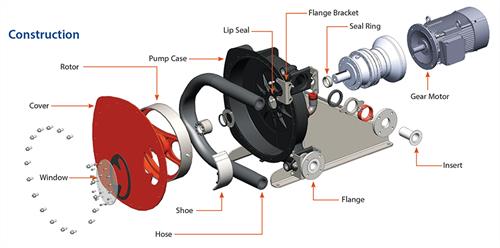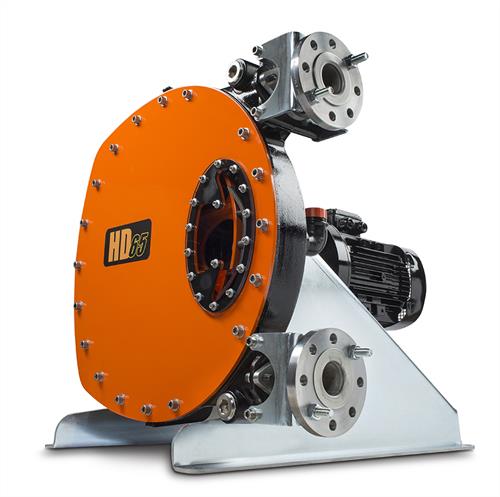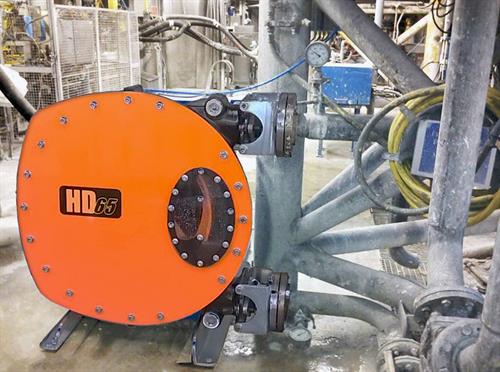The operators in some of the most demanding industries—from oil and gas production to mining and water/wastewater management to chemical processing—rely on peristaltic pump technology when handling thin to viscous, particle-laden, aggressive, abrasive and corrosive liquids in potentially explosive atmospheres.
The Peristaltic Principle
The design and operation of peristaltic pump technology, which was patented in 1925 in France, satisfy the requirements of a wide range of industrial liquid-handling applications because the pump’s operation relies on the alternating contraction and relaxation of the hose, which force the contents to move through the pump and into the discharge piping.
A smooth-wall, flexible hose is fitted in the pump casing and is squeezed between shoes on the rotor that is positioned inside the pump casing. This rotating action moves the product through the hose at a constant rate of displacement. The hose restitution after the squeeze also produces a strong vacuum effect that draws product into the hose from the intake piping. The vacuum created by the hose’s restitution can build discharge pressures of as much as 16 bar, or 232 pounds per square inch (psi), without damaging or deforming the hose, or causing it to rupture.\

The seal-free design and construction of peristaltic (hose) pumps makes them dry-run, self-priming and low-slip capable, and may eliminate the chance that leak paths will form or cross-contamination points will be created, which are considerations in oil and gas liquid-transfer applications.
The pump casing is also lubricated to cool the pump and lengthen the service life of the shoes and hose. Since the product only contacts the hose and inserts, and not the internal pump components, this pumping technology is suitable for abrasive and corrosive applications. The pump’s reversible operation also allows for pumping in both directions.
This pump style also maintains excellent volumetric consistency, making it ideal for the strict dosing and 24/7 operating cycles that can be required in many industrial applications. It can also provide suction-lift capabilities as much as 9 meters (29.5 feet). Peristaltic pumps do not need seats, valves, glands or mechanical seals, which leaves the hose as the pump’s only replacement part.

The peristaltic (hose) pump's ability to maintain excellent volumetric consistency and provide suction lift up to 9 meters (29.5 feet) makes it ideal for the 24/7 operating cycles that are common in oil -and -gas production.
Peristaltic pumps have a seal-free design that makes them dry-run, self-priming and low-slip capable. This design can eliminate the chance that leak paths will form or cross-contamination points will be created.
The peristaltic pump’s hose and inserts—which, because of the pump’s sealless design, are the only componentsto actually come into contact with the pumped medium—need to achieve the highest level of material compatibility, while also reliably delivering the millions of pumping cycles required during its lifetime. That is why peristaltic pump manufacturers have taken great pains to work with hose suppliers who offer products that are compatible with a wide array of chemical compositions, knowing that leaking acid or some other potentially harmful or dangerous liquid will be a disaster for the operator.
Another consideration when selecting a hose material is its “fatigue resistance.” This trait defines how resistant to failure the hose material is as it runs through millions of pumping cycles. A hose material susceptible to developing cracks and holes early in its operational life is not as desirable as a material that can reliably handle the demands of the repeated contraction and relaxation of the hose, especially when particulate-laden liquids are being pumped.
The reinforced construction of the peristaltic hose and its use of rubber compositions that have been specially designed for the stresses within the peristaltic hose allow for the optimum life cycle and performance. The following materials have gained wide acceptance for use in the construction of peristaltic pump hoses:
- Natural rubber (NR):highly resistant to abrasion
- Natural rubber ATEX:for applications in explosive-atmosphere areas
- Buna-N (NBR):provides wear resistance when used with oily liquids
- Buna-N FDA: for hygienic applications
- NR FDA 1935/2004: for food-grade applications
- Ethylene propylene diene monomer (EPDM) rubber: optimized chemical resistance when handling concentrated acids, alcohols and ketones
- EPDM ATEX: for EPDM applications in explosive atmospheres
- Hypalon: high resistance to oxidants, concentrated bases and acids

Peristaltic (hose) pumps are able to operate safely, efficiently and reliably in many of the harsh liquid-transfer applications that are prevalent in oil and gas production. (Images courtesy of PSG Dover)
Oil & Gas Applications
The peristaltic pump’s construction, method of operation, liquid-handling range and low maintenance requirements make it ideal for use in harsh operating atmospheres. One of the harshest—and most complex—is oil and gas production. The operations can be located in some of the world’s most rugged, unforgiving climates and landscapes. Within each operation, numerous liquid-handling functions need to be completed reliably and flawlessly in order for the production operation to be fully optimized.
The bottom line is that everywhere oil and gas products are being recovered from the Earth’s core is the result of a massive, complicated undertaking that requires large amounts of fuel and other liquids to keep them running effectively and efficiently. A common example is the hydraulic fracturing process being used to produce much of the shale oil and natural gas found in the United States and Canada. The fracking process requires thousands and thousands of gallons of water to be sent down the wellbore. This water delivers the chemicals and frac sand that open up the reservoir and allow trapped oil and natural gas to flow to the wellhead on the surface.
Once the fracked oil and gas is collected, the water sent down the well, which can contain a large amount of particulates and contaminants, must also be delivered to the well’s surface and either disposed of or recycled for further use. When the actual oil and natural gas rushes to the wellhead, it can feature varying liquid viscosities and particulate levels, depending on the geologic makeup of the well.
So, the oilfield operator requires a pump that can do three things: handle the pressures required to complete the pumping operation; handle large volumes of liquids with varying viscosities and particulate levels; and maintain volumetric consistency while producing flow rates that can be as high as thousands of liters per minute.
Conclusion
When looking for a pump technology to check all of the operational and compatibility boxes that contribute to an effective oilfield production system, peristaltic pumps can prove to be a strong candidate. The pump’s design, construction and operation make it ideal for many of the unique—and harsh—liquid-handling applications that help define success in the world’s oilfields.